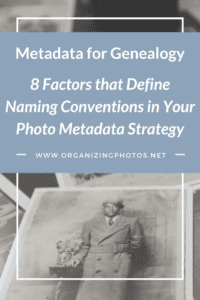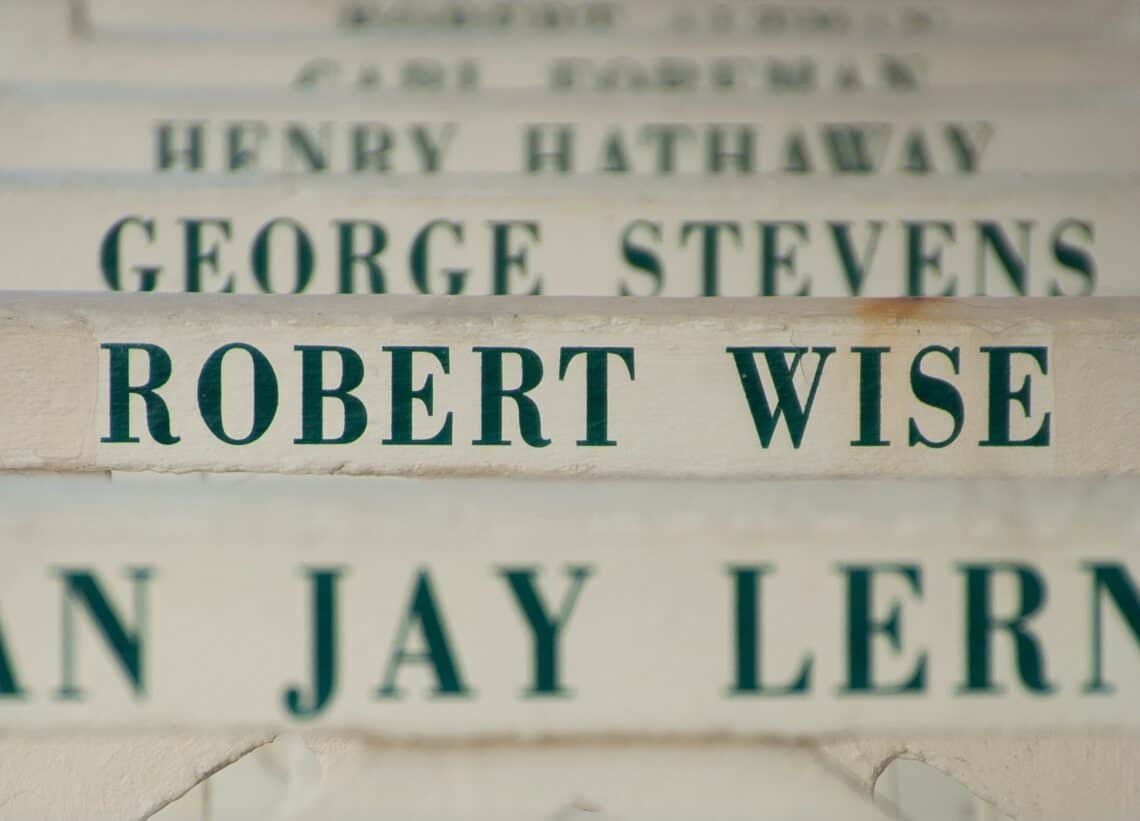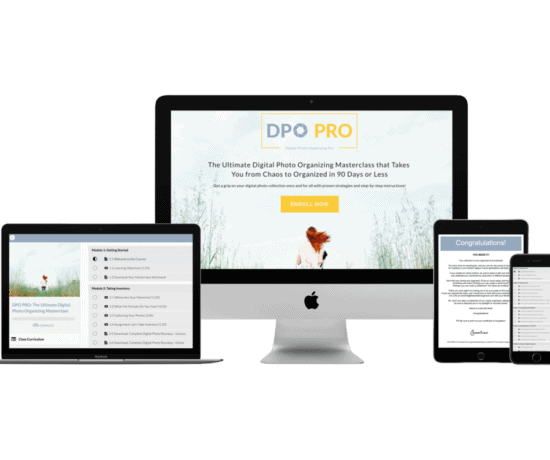It’s time to talk naming conventions!
Recently here on the blog, we talked about exactly why we need to have a solid photo metadata strategy and document it for others. It’s not only to be able to be more efficient, but to be able to pass on the information to others in a meaningful way. If you missed it, click here to catch up.
This week, we’re continuing our current blog series by talking about naming conventions and why they’re the most important piece of your metadata strategy. Read on to find out what to think about when implementing naming conventions in your photo metadata. Turns out, there’s quite a bit to think about… 😉
The Stickiest Metadata Issue? Naming Conventions.
Shakespeare asked: “What’s in a name?” A lot as it turns out.
If you’re an avid genealogist, you’ll admittedly face several important decisions when creating your family photo archive. However, none of them will give you more trouble than your collection of naming conventions. Oh yeah, this is a big one. And that’s why we’re dedicating a whole post to this topic. Please note that we can’t possibly account for all scenarios in one post, but we can at least round up the most important questions you should be asking.
Naming conventions are by far the most difficult thing to figure out in your metadata strategy because your photo life revolves around relationships. Relationships are complicated, and no two families are alike. People are unique and multi-faceted, so we need to respect that and include all of their wonderful sides. But how? By asking ourselves some questions, contemplating the possibilities, and making some decisions on how to move forward, that’s how.
Illustrating the Problem
A newbie wrote us the following email last year:
Hey Caroline! Quick question. Which name should I use in my archive for the ladies? Maiden and married names? This feels so confusing and I don’t want to do this multiple times because I messed up. Should I do “Clark Venita” or “Thompson Venita,” or do I select them both for each photo? What about me? I’ve been married two times as well, so I might need to add those names too, right? HELP!
Unfortunately, that quick question doesn’t come with a quick answer.
Here’s another email that came in shortly thereafter:
My dad was known by several different names, depending on who knew him. How do I best assign keywords? Do I do “Patterson, Paul William,” “Patterson PW,” “Patterson Bill.” What about “Billy” or “PPW,” or do I assign all of the above keywords to my father in each photo?
Ah, the crux of naming conventions… but I think it goes without saying that you cannot enter metadata based on who is looking at the photo at any given moment. That just doesn’t work. Subjective speculation leads to messy metadata.

I’m a Perfect Pinnable!
8 Considerations to Ponder for Your Naming Conventions
So what should you think about in terms of names when you’re strategizing your new naming conventions?
Below are the top 8 factors that I believe will define your strategy more than anything else, and that I suggest you tackle first.
They are:
-
Married vs. Maiden Names
Throughout history (and in many different cultures), women have changed their maiden names upon marriage. Those names are often lost to time, which is why it’s much harder to research female ancestors. You have to strategize how to preserve that information, so you don’t lose that bit of history. You also have to make a decision on how to preserve the married name(s), so you have current information on a person. This is often a source of confusion for beginners, so a solid strategy should clear this up. Which name will you use, why, how, and in what format? If both, how will you differentiate between them? Let’s iron that out.
-
Multiple Married or Added Names
What if someone has been married multiple times, or has added names due to some other event? How do we document and format those, so we don’t lose the connection to potential records, people, and places? You will come across this somewhere in your photo archive – guaranteed – so it’s worth thinking about upfront. How will your naming conventions address this issue? And how will future generations understand which name is which?
-
Other Legal Name Changes
Name changes happen for a variety of reasons, not just due to marriage. We have worked on plenty of archives where we have dealt with legal name changes due to adoptions or other personal reasons. How do we handle those in a sensitive manner, honor personal preferences, yet still keep the linkage to earlier photos and records? Your metadata strategy should address and standardize this scenario clearly.
-
Nicknames, Stage Names, and Aliases
You may not know anyone with a stage name or alias (fun fact: I do), but you’re certain to know someone with a nickname. These are not necessary legal name changes, but can be equally important. I often refer to my daughter’s idol “Coco” Chanel. What if someone has a significant nick name, but doesn’t always show up in records by that name? How will you handle those situations in your photo metadata? We need to standardize this, so that we preserve the connection to letters, home movies, and other family memorabilia where the person appears under that name. It may be obvious to you now, but down the line, it won’t be. Resolve that kink.
-
First Names vs. All Given Names vs. Addressed-By
It’s not uncommon for people to have multiple given names, and in many cultures, this can pose a real problem when trying to create naming conventions. Take my name, for example. My full maiden name is Eva Susanne Caroline Nilsson, but I’m not known as “Eva Nilsson.” In Swedish culture, your first name is not necessarily what you’re addressed by, so if someone down the line searches for records on Eva Nilsson, they’ll come up empty. That’s a problem.
If someone has multiple names, how do we best communicate those? The naming conventions in your metadata strategy should make this very clear.
-
Generational Names
When there are multiple generational names, for example those that end with Sr. and Jr., how will we differentiate between those people in our photo metadata?
I have several people in my family archive with the exact same name due to the patronymic naming system that was in effect in Scandinavia for hundreds of years. Unless I had a clear strategy for how to find and identify the right person, I wouldn’t be able to stay organized for very long. Your metadata strategy must specify how you’re going to resolve identities for people with the same or similar names.
-
Titles, Ranks, and Numbers
You’d be surprised how this shows up in people’s family archives when they least expect it. Whether you have royal ancestors, military heroes, or doctors in your family tree doesn’t matter, but how you treat them does. How much information do we specify in the photo metadata? Do we spell out the title? Exclude the title? What if a person had a title so significant that it encompassed their entire historical identity? It happens, believe me. Your photo metadata strategy needs to address this, or you won’t get very far.
-
Language Barriers
When there are multiple cultural elements in a family photo archive, how do we account for the language barrier on behalf of those who will use the archive? Many languages use characters that other languages don’t. Your strategy should specify and outline guidelines around this, so that we can stay consistent and accurate in our photo metadata.
An example I often use in my classes is “Jöns Nyström,” which is a typical run-of-the-mill Swedish name. Notice that the name uses the Swedish letter “ö” twice. Now imagine that you are the descendant of this man and less familiar with Swedish culture. You may mistakenly assume that this letter is a variation of the English letter “o,” therefore spelling the name “Jons Nystrom” in your archive. This is incorrect.
The Swedish letter “ö” is an entirely different letter than “o” (basically, it has nothing to do with it), so if you were to put that in your archive, you’d be identifying your ancestor by the wrong name. Now, every time you (or someone else down the line) search for records on this person, you won’t find him. Enter the genealogical brick wall.
Oops, Need to Start Over with Your Naming Conventions?
The above-listed considerations are just a few examples, of course, but I hope it illustrates the point I’m trying to make. Our metadata strategies must address these types of issues, so that you can be clear on what type of information you are embedding, and how.
If you’re feeling triggered by this article because you’re now questioning how you currently do things, don’t worry. Take a deep breath. We can fix it, even if it means starting over. One do-over is better than continuing going down the wrong road indefinitely. This holds true whether you’re a hobbyist who just wants to pass on your stories, or a pro who wants better strategies to help clients set up organized archives. Investing in learning how to do this the right way is always worthwhile.
These problems are common, so you’re far from the only person who might find this difficult. That’s why I have an entire workshop dedicated to this topic, and why I coach so many people through this planning process. Systems and operations, project management, and planning are at the heart of what I teach because that’s what creates productivity and efficiency. In short, it’s how we do things ONCE, instead of worrying about do-overs. Join us in being organized!
Want to Learn How to Strategize Better?
If you’re interested in learning more about creating your own metadata strategy, consider enrolling in our Metadata for Genealogy Workshop. We held it last year during family history month, and the replay is available for anyone who may have missed it. See the preview below.
This is by far our most popular workshop, and in it, you’ll learn exactly what IPTC metadata fields to use, and what to consider when putting together your own family archive metadata strategy (simple template included). Naturally, all of my recommendations are in there too, so you have references and a place to start.
For more in-depth help that starts from the absolute beginning, consider joining us in our full course DPO PRO: The Ultimate Photo Organizing Masterclass. That’s where we strategize together, and help you through each step of the photo organizing process. And… BONUS: For a limited time, you get our Metadata for Genealogy class free when you enroll in DPO PRO. Yep, it’s a two-fer!
We also have private coaching sessions available for anyone who’d like to fool-proof their procedures, so let’s make this strategy solid. If you’re gonna do this, spend your time doing it right, so that you can create the legacy your family history deserves. You won’t regret it.
Featured Photo Courtesy of Philippe Awouters





